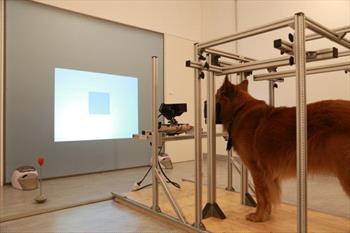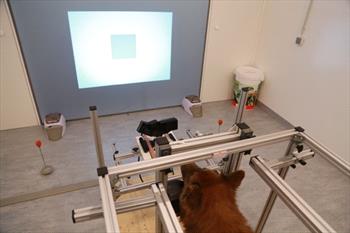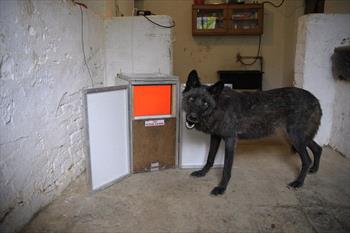One of the perks of lecturing around the world is that I get the opportunity to meet researchers and hear about their incredible studies. These are studies that shed light on how animals learn and perceive our world and consequently how we can better communicate and interact with them.
These experiences are even more exciting when I find that the researchers are using the Treat&Train®, a remote controlled treat dispenser which I developed in 2004 to be used, especially where precision is needed in training. So, last year when I visited the Clever Dog Lab at the Messerli Research Institute in Vienna as well as the Wolf Science Center in Ernstbrunn, Austria, I was practically ecstatic. Treat&Trains were being used for many types of experiments and consequently helping the researchers answer interesting questions about behavior.
Here are three of the experiments where Treat&Trains were utilized:
Eye Tracking Studies
“In the Clever Dog Lab of the Messerli Research Institute in Vienna,” states Ludwig Huber, Ph.D, Head of Comparative Cognition at the Messerli Research Institute, “we are conducting eye tracking studies with dogs. Eye tracking is a tool for determining the point of gaze, which allows conclusions about the perception of relevant stimuli and the underlying cognitive processes of dogs.”
For instance, eye-tracking studies in humans are used to answer questions such as “where do humans gaze when they look at a web site or an ad.” The results help graphic designers and marketers create designs that get better results. Or a general question might be, what feature of an image draws the eye. If researchers are then studying whether a dog can recognize specific objects or people, the eye tracking information may be helpful in determining what aspect of the person or object the dog is using to distinguish between one from another or which is the most salient feature that enables the dog to accomplish a visual task.
Pretty cool and simple, except that unlike with people where you can tell them exactly how to interact with the eye tracking system and what to do, you have to train dogs first.
Says Huber, “Before we are able to do eye tracking with the dog, we first train the dog to lay its head on a pillow (chin-rest) and hold still for several seconds.” This is easily taught just by marking the correct behavior with a clicker and then immediately rewarding with food and then building up the length of time the dog can hold his head still on the chin rest to 30 seconds.
“Next, we need to do a calibration of the system. While the dog’s head is on the chin rest, we present on a screen in front of him, one of two different geometric figures (such as a triangle and a square). Only one geometric figure is shown at a time and the one that is shown varies on subsequent trials.”
The researchers pre-determine that if one figure (such as a triangle) is displayed and the dog gazes at it, he will receive a rewards from the Treat&Train on the left of the screen and if the other figure (such as a square) is shown and the dog gazes at it, he’ll be rewarded by the Treat&Train that’s to the right. The Treat&Train provides the precise timing that’s needed for this training and ensures that there are no human cues that could confound the testing.
“This training procedure is called a conditional discrimination procedure,” says Huber. “Once the dog has learned this, one can do the calibration, which requires the dog to fixate on the figure shown at three different positions of the screen.” And once the dog can do this, then gaze experiments can be started!
During studies, dogs stand still with their head in the chin rest and during this time, they are shown pictures (up to five in a sequence) and then a symbol. When they are gazing at a picture, they have to watch it in sum for at least two seconds (up to five sec) and then the next picture/symbol is shown, but if they see a symbol, they can immediately go and get their reward. Their gaze is tracked to see what aspects of pictures they look at. Then the symbol is used to end the session at which time the dog goes to the Treat&train to get his reward.
Interestingly, during the training stages, Treat&Train targets (a red foam target sitting on an antenna-like stick) are used as an additional cue that the dog has made the decision correctly. The dog has to touch the target to receive his reward from the specific feeder. This step is important because, says Huber, “Some dogs (especially herding breeds) are so fast, that they will not stop by at the correct feeder even though they are turning towards the correct one! If they have to touch the target, their choice is more explicit because they have to stop (at least for some fractions of a second).”
Consequently, during the calibration stage, dogs are trained that when they see the one figure, then if they touch the target on the left they get a treat. And if they see the other figure, they should touch the target on the right side of the screen and then will get a reward. The target is “faded out” within the course of the training, so that during the data-acquisition only the feeders are left!
Treat&Train used for imitation studies in dogs
Another type of experiment where the Treat&Train is used in experiments is to see if dogs exhibit the Chameleon Effect. The Chameleon Effect refers to the tendency for humans to unconsciously mimic the postures, facial expressions and mannerisms of interaction partners. This mimicry is thought to increase social cohesion because when individuals are paired in experiments with someone they have never met they rate that person as more likeable if that person has mimicked them.
In the Clever Dog Lab, researchers have found that dogs are able to imitate other dogs and humans. In a new study on the Chameleon Effect, researchers have examined the effects of dogs being imitated by a human person.
In this set-up, the dog is on a leash held by a handler and is directly facing a human stranger. The Treat&Train is next to the stranger and the dog’s owner is on the other side of a wall that’s next to the stranger. The wall keeps the dog from going over to the owner after he gets a reward from the Treat&Train.
The dog’s owner gives a command to the dog to perform a well-known action such as “sit.” Then the stranger either imitates the dog or performs a different action. There are two strangers designated for each study. One will imitate the dog, the other is a control stranger who will perform a different action. Only one stranger is present at a time. In either case, the dog receives a reward from the Treat&Train for performing the command and then watching the stranger. Situating the Treat&Train near the stranger increases the likelihood that the dog will watch the stranger and his or her actions. The stranger is not allowed to interact with the dog, but rather the treats are dispensed by the handler operating the remote control.
The trials with the imitator stranger and the control stranger are randomized and the dog sees each stranger the same number of times.
Then, later, the researchers perform a test of affinity on the dog, using a standard approach test in which the two experimenters—the imitator and the non-imitator—are standing approximately 3 meters from each other. The dog is brought into the room and allowed to move freely. An observer measures which person the dog approaches first, how much time the dog spends near each person, and how many times he interacts with each person.
This study is in progress, but based on the Chameleon Effect the investigators predict that the dogs will develop a greater affinity for the stranger who mimics them compared to the one who does not.
Treat&Train used for studies of numerical competence of dogs and wolves
A third use for the Treat&Train in research is in a common discrimination study. Huber describes, “Comparing amounts and numbers is essential for our lives and it may be that non-human animals share the ability of numerical judgment. Many previous studies attempted to provide evidence for numerical competence in different species like monkeys, birds, fish and bees. Additionally, a few studies have tested for numerical abilities in dogs. These studies only looked at small quantities and may have failed to control for additional cues.”
As a result, the researchers at the Clever Dog Lab and the Wolf Science Center designed a computer-controlled task which could be easily trained. In this task, dogs and wolves are presented with two screens—one with a large number of objects and one with a smaller number of objects. If they correctly select the display with the larger number of objects (or smaller number, whichever the particular individual has been trained to select), they receive a food reward from the Treat&Train. If they touch the wrong display the screen goes blank and they are unable to try again for several seconds.
Cognitive Studies Using the Treat&Train Abound
These are only three of the studies that the Clever Dog Lab and the Wolf Science Center are working on. With their robust gathering of graduate students, they are rapidly performing many more. It’s exciting to think that a product that I have developed is helping them advance science!





